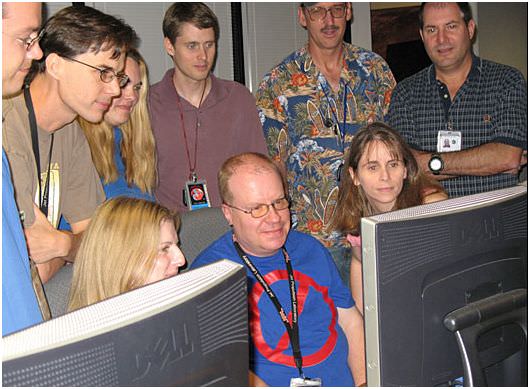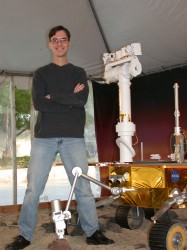[/caption]
In preparation of celebrating Spirit and Opportunity’s fifth anniversary on Mars in January, we’ve been talking with rover driver Scott Maxwell, getting updates on the two Mars Exploration Rovers and learning about what it really is like to drive the rovers. Today, Scott will share some of the highlights of the past five years, and his outlook for the future. But first, in the latest updates from Scott via Twitter, he says Spirit tried to back-up off of ‘Home Plate’ but encountered quite a bit of slippage. It looks like she’ll probably end up driving forward and taking the long way around the low plateau to the next target objects, a hill called Von Braun, and a crater-like feature nearby called Goddard. Meanwhile, Opportunity is studying “cobbles” or loose rocks at a region called Santorini, where she has been stationed during solar conjunction. Now that radio transmissions are improving, Oppy will start receiving commands from the rover drivers to hit the road again. The image above is a panoramic image of Santorini, put together by James Canvin at his website, Martian Vistas.
Scott has actually been with the MER mission for longer than just the five years since the rovers landed. He joined the team early on, about three-and-a-half years before the rovers launched. He was part of the development team, helping to write the software used to drive the rovers. Back then, did he ever fathom the rovers would last this long?
How to Drive a Mars Rover, Part 1
How to Drive a Mars Rover, Part 2
“I think back, to that time, and we did all that work where we sat in our cubicles, had meetings and argued with each other about the best way to program the software,” said Scott. “We slaved away working on the mission, never knowing if the mission would succeed or not. We did all that work just for the chance, the hope, that the rovers would be working on Mars for three months. And it was worth it.”

“And then to do all that work and have the rovers on Mars for five years, it’s like you’re playing a slot machine and you put in your quarter and pull the lever, and not only do a few quarters come out, they keep coming and coming and coming, and it fills up your cup, and overflows. That’s what it’s like to work on this mission.”
OK, Scott, now we want to know the highlights for you from the past five years. Certainly there’s at least one or two memorable moments!
“Certainly for me, there are two things I think of,” Scott said. “One is the first time I ever drove the rover. There was the period early on where we lost contact with Spirit. But then we were able to recover her. But that was a month into the mission where we thought it was only going to last three months, and it delayed the time until I got my first chance to drive her.”
“I still remember the day. We planned and planned and rehearsed the drive. I checked over the sequence a million times before sending it. Then I went home and I should have gone to sleep, but I couldn’t. I just laid there in my bed and stared at the ceiling, and couldn’t get past the thought that right then, at that moment, there was a robot on another planet, doing what I had told it to do. It was just an awesome feeling to imagine that, and that feeling has never left me. I still feel like that every time I drive the rover.”
Scott says it’s an incredible feeling to go outside and look up and see Mars in the sky, and on that red dot way out there is an object, placed there by humans, and humans are telling it what to do. “And I’m one of the people doing that. It’s an absolutely amazing feeling. I feel that way all the time.”

Its obvious Scott has a soft spot in his heart for Spirit, as another memorable aspect of the mission involves her, too. Scott tells the story so well and with such passion, I’ll just let him go:
“The other thing I always think about is that Spirit travels the 300 million miles to Mars, she gets to Mars, drives off the lander, and she’s gone all that way with the hope of finding evidence of past liquid water on Mars,” Scott said. “But instead, when she drives around, there’s nothing: just lava as far as the eye can see. She drives around the area and looks at rocks, and then drives over to Bonnevillle crater, which is her best chance of finding evidence of liquid water, thinking maybe if she goes down far enough into this crater there will be something there, but there’s nothing.”
“But way off in the east, there are a range of hills, the Columbia Hills, and (principal investigator) Steve Squyres says clearly the hills may be too far for us to get to, but maybe we can get some images that can tell us something. But Spirit takes off for those hills anyway, even though they are too far away, and never gives up and gets there; she actually makes it all the way to the bottom of the hills.”
“And then,” Scott continued, “she’s at the bottom of the hill, looking up at them, and it’s now twice as long as she should have survived and she has driven three times as far as she was supposed to be able to drive, and she’s tired and her wheels are sore, now is when the real challenge will begin. Now she won’t just be driving over flat terrain, like she was meant to drive on. She’s going to have to climb the hill, which is taller than the Statue of Liberty, and everyone thinks it’s way too tall for this poor little rover to climb. But she does it anyway.”
“She starts climbing up the hill and there are times when she can’t make any progress, so we have to turn her around and give up some of the altitude she’s won and go back and find another path, but she never gives up and goes all the way to the top of that hill that was just impossibly far away when she started.”

“When we came into work that day and we saw that image of Spirit standing on top of Husband Hill with the beautiful panorama of the world around her –she stood there for a long time and took the images of the area around her — to me, that’s one of the achievements, not just of this mission, but of engineering excellence in our whole civilization, to be able to do that. To be able to go so far and do so many impossible things, that image just says all of that for me. I know what it took to get there and be able to take that image, and I feel the pride of being part of the team that made it happen. It is just an amazing experience.”
As incredible as the MER mission has been, we all know the rovers won’t last forever. Someday – and we don’t know when – the rovers will eventually quit working. It’s hard to think about life without the rovers, but has Scott given any thought to what mission he would like to work on next?
“It’s all downhill from here!” Scott laughed. “But, really there’s a lot of cool and exciting stuff going on at JPL. We’ve got another rover we’re working on, the Mars Science Laboratory, and I’ve been working on that. I’m also involved with ATHLETE, which is a 12-ft. tall six legged robot spider on roller skates that we are going to send to the moon. There’s always so much like that going on here at JPL, it’s just like being an engineer in Disneyland. You come to work and say, ‘What cool stuff can I work on today?’ It’s just awesome, and there’s just no end to it.”
Scott says he has nothing against orbiter missions, but to be honest they’re not top on his list. “I’m not putting them down,” he said, “but orbiters don’t really float my boat. I kind of get into rovers, I kind of relate to them, in a way. But you look at a mission like Cassini and it’s amazing! Cassini is finding liquid water spewing out of Enceladus, and dropping a probe onto Titan and getting the first view beneath the thick clouds that cover that moon! It’s just amazing stuff. So even though orbiters aren’t my thing, I might end up on one of them, too, you never know.”
Scott has definitely shown his worth with the rovers, so, even though the MSL launch has slipped to 2011, the rover fans out there are secretly hoping Scott will have a place on the MSL team when the time comes.

But in the meantime, Spirit and Opportunity, the Energizer Bunnies of Mars exploration keep going and roving, and sending back loads of data and images.
JPL has put out a video to celebrate the rovers’ five years on Mars, where Scott says it best: “It seems like every day is better than the day before. The mission keeps getting better and better the longer it goes.”
Happy birthday Spirit and Opportunity! We’ll take as many years as you can give us!


hey cheers for that… very informative – i’ve added your blog to my netvibes account – thanks 🙂